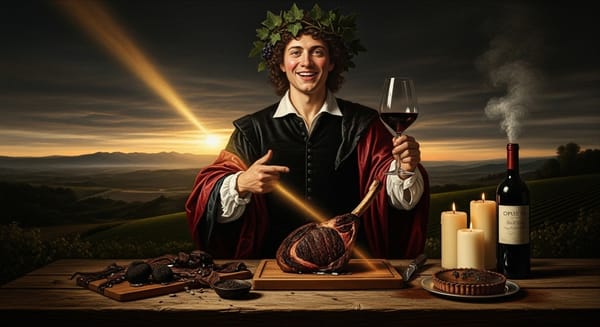Puligny‑Montrachet | Grace Under Tension – An Immersive Portrait
Puligny‑Montrachet is Burgundy’s paradox: purity that hums with restrained power. Explore its monastic origins, stony slopes, precise winemaking, and the producers who translate tension into timeless Chardonnay.

Where Light Sharpens the Vine
There is a stretch of hillside in the Côte de Beaune where sunlight feels sharpened rather than warmed. Mist drifts aside, and the vineyards appear to inhale as one, holding something barely contained. Puligny‑Montrachet lives in that tremor—serene to the eye, turbulent beneath the surface. A first sip discloses the secret: beneath apparent clarity runs a current powerful enough to turn stone into memory. The village offers no spectacle; it invites pursuit. It knows that true intensity rarely announces itself.
Echoes Held in Stone
The earliest caretakers of these slopes were Cistercian monks who believed that work conducted close to the earth was a form of prayer. Their records describe parcels divided and redivided, delineated not by law but by patient observation: one row ripened earlier, another yielded berries that carried a keener scent. Over centuries this quiet taxonomy became an invisible map of worth. By the 18ᵗʰ century merchants in Beaune spoke of Puligny wines with a guarded inflection: something rare yet essential, like salt fetched from a distant sea.
Revolution broke the monastic hold, fragmenting land into mosaics of family plots. Each inheritance tightened or frayed the weave, and still reverence deepened. When the word “Montrachet” attached itself formally to Puligny in 1879, it was less a rebranding than a public acknowledgment of an already whispered hierarchy. Wars scarred the Côte but could not alter terroir or the stubborn faith of those who worked it. After 1945, as global palates widened, export markets discovered what local innkeepers had long known: if Meursault smiled and Chassagne sang, Puligny stood so still that the taster moved toward it, as though drawn by magnet rather than sound.
Today, the village remains modest in population and architecture, its fame residing in the hyphen it shares with Montrachet. Roads narrow into lanes, stone houses lean toward vines, and the tempo feels unchanged. Yet allocations travel instantly across hemispheres, and a single vintage’s fortunes ripple through auction rooms in Hong Kong and New York. Muted in outward gesture, Puligny speaks loudly along the invisible networks of desire that connect collectors, sommeliers, and dreamers.
Slopes That Drink the Dawn
Sunlight as Blade
Puligny’s vineyards begin their ascent gently, then steepen just enough to tilt fruit toward dawn. East and southeast exposures welcome early light that coaxes ripeness without exhaustion. Beneath midsummer skies the vines seem to vibrate, tuned by wide diurnal swings that cool nights deliver. Heat never lingers long; evening breezes slide down from chalky woods above, letting acidity tighten like a drawn string.
Stone as Tuning Fork
The soils here are a dialogue of marl, limestone fragments, and lighter scree, interrupted by pockets of clay that lend subtle weight. Walk Les Perrières after a rain and the ground exhales something between ozone and crushed shell—less an aroma than a keen sensation behind the eyes. The stones do not declare themselves; they resonate, acting as tuning forks that set Chardonnay humming at a register higher than neighboring villages. Drainage is swift, root systems plunge, and berries remain small—concentration achieved through scarcity rather than force.
Weather as Engraver
Puligny’s climate supplies drama in miniature. Spring teases with warmth, then snaps cold to remind vignerons of frost’s perennial gamble. Summer rain is sparse but surgical, carving definition more than volume. Autumn lingers, sunlight thinning day by day until grapes taste of both fruit and air. In generous years harvest arrives under brassy skies; in leaner seasons pickers race impending squalls. Through each variation one constant endures: tension preserved by nights that give back what days almost take.
A Choreography of Restraint
To farm Puligny is to practice restraint seasoned with nerve. Growers thin shoots only when canopy threatens to overshadow fruit; they pluck leaves selectively, allowing clusters a glimpse of sun yet never full exposure. Yields are measured in what they choose not to pick. The Grand Cru parcels—Montrachet spread like a regal mantle midway up the slope, Chevalier poised higher as if already ascending, Bâtard and Bienvenues offering breadth and charm—receive touch so light it seems more listening than labor. Premier Cru vineyards such as Les Pucelles, Les Combettes, and Les Folatieres embody their own micro‑temperaments: one austere, one perfumed, one restless. Vignerons treat each personality with a dancer’s sensitivity to partner and pause.
Organic and biodynamic methods find fertile ground here, less from trend than intuition. Chemical shortcuts would feel jarring against the village’s ethos of patient subtraction. When disease pressure rises, timing matters more than volume; copper and sulfur are deployed like punctuation, sparingly yet decisively. Harvest crews move row by row with small buckets, discarding any berry that does not meet an almost private criterion. At the weigh‑station, silence reigns until sugar, pH, and total acidity whisper their alignment.
Crystal Voltages of Chardonnay
Chardonnay, elsewhere malleable, becomes in Puligny a study in tensile strength. Aromatically it glints—white blossom caught in cold breeze, lemon zest shavings, the faintest memory of underripe nectarine. On the palate it feels like water turned crystalline mid‑flow: brisk yet not thin, concentrated yet never heavy. Salinity skims the finish, hinting at subterranean journeys through strata older than language. Texture grows with air, shifting from blade to silk‑paper friction, then returning to clarity as if rinsed by its own minerality.
Red Puligny—Pinot Noir few in number—offers a ghost of what might have been: pale garnet, cranberry‑flecked, pepper at the margins. These bottles surface occasionally at local tables, more anecdote than commerce. They remind drinkers that soil chooses its interpreter, and here Chardonnay holds the stage.
Hands That Vanish, Wines That Remain
Great Puligny resembles a vanishing act. Grapes enter the cellar intact, often chilled by over‑night air. Pressing is slow, pressure rising in increments like cautious conversation. Juice settles briefly, then ferments in oak whose grain whispers rather than shouts—one‑third new at most, often less. Indigenous yeasts chart unrushed pathways; temperatures are guided but not regimented. bâtonnage is practiced sparingly, a gesture rather than a routine, ensuring lees impart breadth without muting line.
Malolactic conversion proceeds at its own rhythm; some vignerons encourage it through cellar warmth, others simply wait. Élevage stretches twelve to eighteen months, the wine absorbing oxygen through stave and bung, gathering composure. Racking is minimal. Filtering, if applied, aims only to clarify thought, never feeling. The result is a liquid with edges polished but intact, capable of carrying the vineyard’s cadence into decades. True mastery reveals itself in absence: no excessive wood, no overt sweetness of fruit, no fatigue. As one veteran grower murmurs, “If you notice my hand, I have failed.”
Four Voices in a Silent Cloister
Domaine Leflaive inhabits Puligny’s spiritual center. Since the pioneering biodynamic shift of the late 1990s, its wines have glowed—Les Pucelles like morning light filtered through quartz, Chevalier‑Montrachet a blade sheathed in jasmine. Each bottle seems carved from atmosphere, leaving reverberation rather than echo.
A stone’s throw away, Jacques Carillon tends parcels inherited across generations dating to 1520. His cellar is compact, tools few, barrels seasoned. The resulting wines move vertically: Les Perrières rising through palate space as though drawn upward by unseen draft, the village cuvée mapping limestone in Morse code staccato.
Etienne Sauzet directs a symphony of precision. Fruit is pressed fractionally, musts are cooled to preserve aromatic lift, and racking follows lunar cycles more by felt necessity than doctrine. The wines dance on a wire—Les Referts lithe, Les Combettes expansive yet taut, Bâtard‑Montrachet possessing the improbable balance of suspension bridge cables.
Among the modern vanguard, Alvina Pernot brings youthful acuity to heritage parcels. Her versions of Les Folatieres and Champ Gain show mineral sparks amid citrus flesh, proof that tradition need not fossilize. She speaks of “listening to sap flow” and designs élevage around that imagined rhythm.
Each estate, distinct in handprint, converges on a single ideal: to translate underlying energy without static. They succeed by stepping aside.
Time’s Slow Unfurling
Puligny is a chronicle written in diminishing tension. In its first three years, acidity flashes like magnesium—aromas of lemon pith and frost‑tipped pear. Between five and eight, contours knit; a note of almond skin emerges, as if the wine recalls the seed within fruit. Past a decade, color deepens to pale topaz and scents turn autumnal: hazelnut husk, distant hearth smoke, rain on flagstone. Yet even then a live wire remains, conducting freshness long after primary fruit fades.
Store bottles where temperature mimics Burgundy’s own limestone depths—cool, steady, dim. Vibration unsettles the calm; light vulgarizes nuance. Serve youth at cellar coolness, around 11 °C, watching condensation form like first breath on winter glass. Mature bottles benefit from a breath free of cork but dislike vigorous decanting; they unfurl if simply poured and allowed to find their own shape as conversation meanders.
Choose moments wisely. Young Puligny rewards curiosity and bright company. Older Puligny suits intervals when talk slows, and someone at the table notices how dusk gathers at window corners.
Scarcity’s Soft Thunder
Collectors speak of Puligny in paradox: fragile yet indomitable, elusive yet necessary. Quantities are inherently small—Grand Cru hectares countable on fingers, premier crus scarcely more generous. Weather volatility can halve yields, sending allocations into shadow markets before most enthusiasts glimpse a list. Prices rise not in leaps but in sine waves, cresting whenever a benchmark vintage reveals new dimensions.
Crucially, Puligny holds value through integrity rather than spectacle. It lacks the immediate opulence that powers speculative spikes; instead, it accrues esteem as voices of sommeliers, critics, and peers converge around a shared reverence for its restraint. Provenance commands a premium: bottles traced from cellar to table fetch markedly higher sums, because oxidation can sabotage brilliance in ways invisible until the cork is pulled. Investors who understand patience—and the insurance of proper storage—find Puligny an anchor asset: less volatile than cult California, more ascending than stalwart Bordeaux brands.
The smarter play is vertical ownership: consecutive vintages from a single producer, illustrating the village’s conversation with climate over time. Such collections draw scholarly bidders who pay not only for liquid pleasure but for narrative completeness. In markets increasingly drawn to authenticity stories, Puligny’s understatement becomes its loudest credential.
Dusk Over Les Perrières
Picture Les Perrières at dusk: vines dark against a sky flushing rose‑grey, the slope dropping toward a village whose windows start to glow. On a low stone wall rests a glass still half‑full, capturing the last shard of light. The wine within seems to hold its breath, neither revealing nor withholding, simply existing in perfect balance between seen and unseen. Puligny‑Montrachet is that held breath—a moment of charged stillness that lingers long after time resumes. It does not explain itself; it invites you to return, again and again, to chase the quiet thunder rumbling beneath purity.





